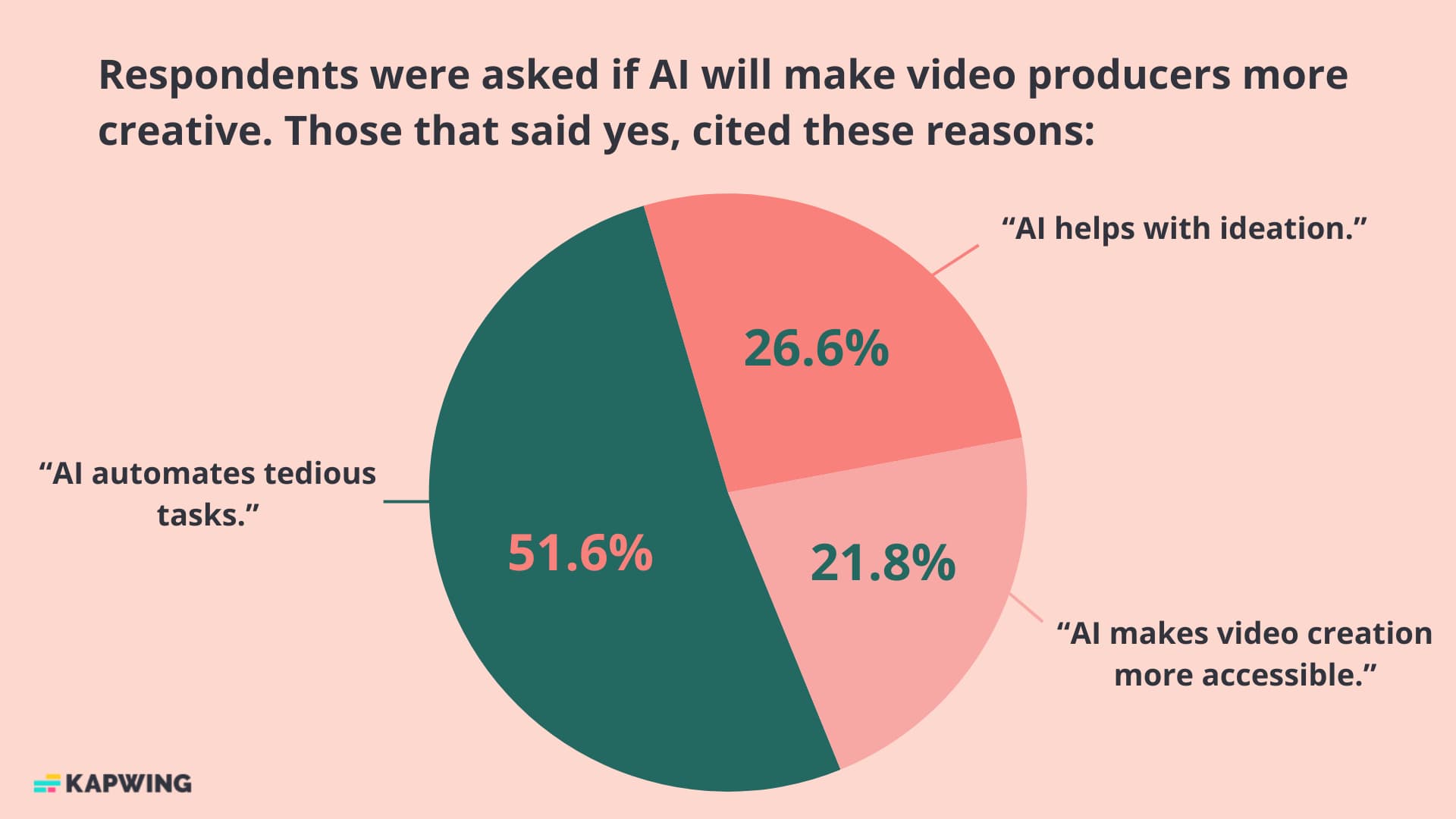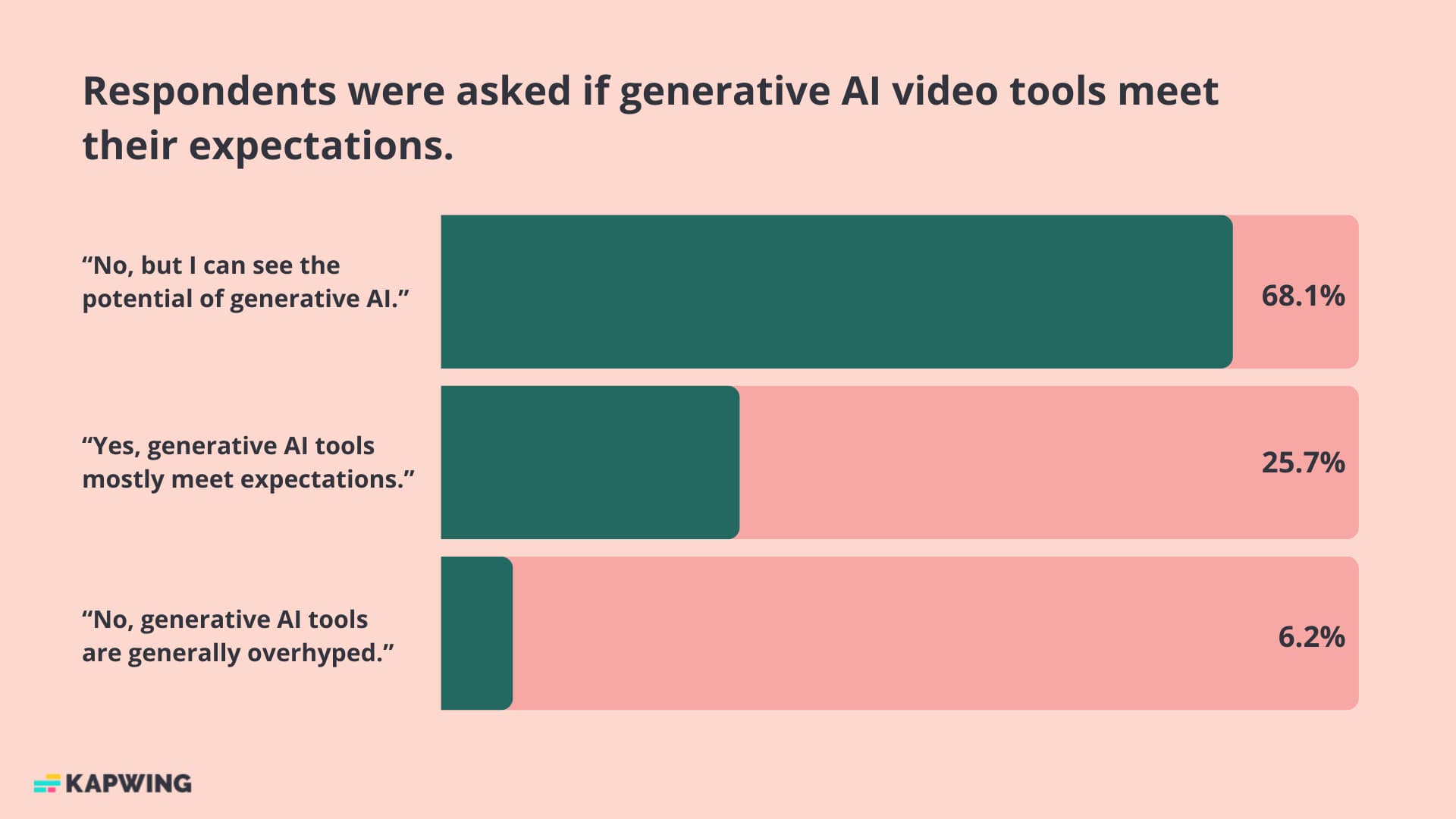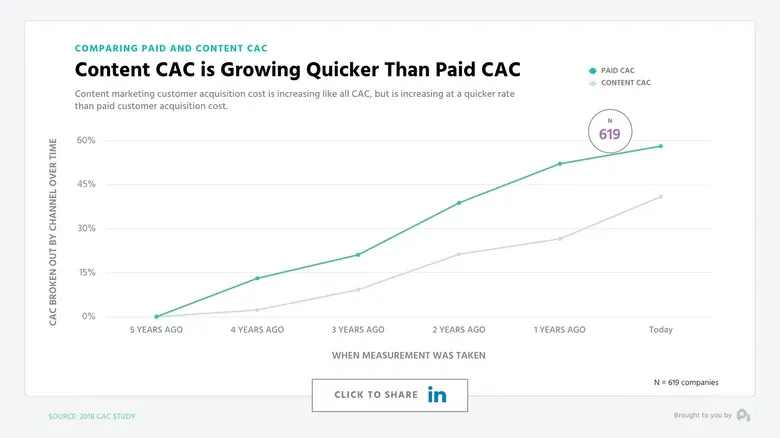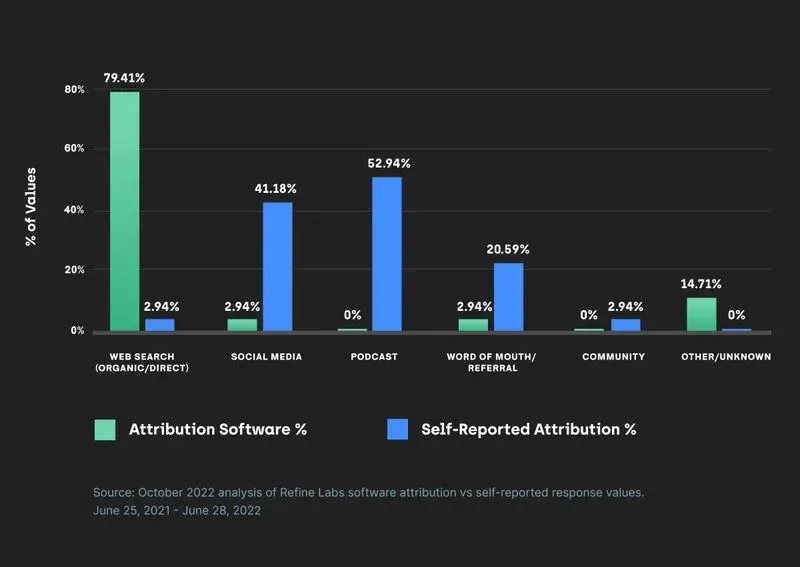The 10 Content Marketing Trends That Will Shape 2024
When the dust settles on 2024, we believe these are the trends in content marketing that will have the most impact.

Content marketing was flipped on its head this year. You know it's been a wild 12 months when all we have to say is, what a year. 🙃 When all we're up and at 'em come January 2024, it's worth seriously asking: Where does content marketing head from here?
There are plenty of prediction posts out there, so we wanted to add some skin in the game by sharing the top trends we're betting our own content strategy around. When the dust settles on next year, we strongly believe these are the shifts in content marketing that will leave a lasting impact.
1. Search faces disruption, but remains a valuable channel
There's no doubt it's been a frenetic year for search with multiple pendulum-swinging algorithm updates coming from Google and the looming impact of AI and, in particular, Google's SGE beta. But there's no need for marketers to abandon ship; dear reader, the death of SEO has been greatly exaggerated.
We recently spoke with marketer John Collins, formerly of Intercom and Ramp, who brought some sanity back to the conversation—along with some data. John's survey of B2B software buyers found that over 80% of buyers said they were at least “satisfied” with the search results, while a full 40% said they were "very satisfied" with most search results.
Buyers still rely on search to evaluate products before they make a purchase, and the visibility a brand can achieve for these searches matters a whole lot.
The data did show that expectations with search results are evolving, however: 60% of searchers said they trust B2B software reviews from third parties more than content published by companies or traditional publishers. What's more, over half of searchers said they "agree" or "strongly agree" that most B2B content looks and feels the same, and is almost impossible to differentiate.
In sum total, searchers' expectations are still being met when they search for information about B2B software products. But, searchers have definitely picked up on the copy-paste effort present in most company-created content and as a result, have begun favoring offsite and external content sources to round out and fact-check whatever the company is saying.
That requires a new, more holistic approach to search and greater investment in offsite efforts not just for links, but for visibility on relevant searches. Search isn't dead, it's just not the same as it was.
2. Brands increasingly use video as their anchor medium for content
I spoke to many long-time content leaders this year; marketers who have been running content programs for over a decade, and some nearly two. When most of us got started, every content strategy started with a blog—it was the default medium, the one every team expected to begin with.
Now, though? Most of the marketers I spoke to said investing in a company blog might fall closer to the bottom of their list of initial priorities if they were working with a brand-new startup, or in specific industries. That doesn't mean blogging is left to a bygone era, just that it's not the default or central channel in the way that it used to be.
We're increasingly seeing brands start with some sort of interview-style video format as their anchor medium these days, and we predict that will continue into next year. There are three pivotal reasons driving this shift:
- Video is the best fuel for a content engine. Want to show up everywhere your customers are? Video is probably the format that works best overall. A long-form video can be repurposed multiple times and with the right video format, you can essentially power your entire social media calendar.
- Video works best for expert-led content. It's hard getting genuine subject matter expertise into your content. Video works well because it helps your in-house experts feel more authoritative, or allows you to interview and record external experts to provide advice outside of your wheelhouse.
- Existing channels are all seeing major shifts. HubSpot’s data says that brands plan to invest substantially more into short-form video, influencer marketing, and SEO next year. Video obviously powers the first two, but videos are also becoming much more prominent in the search results. Add the dramatic uptick in video consumption seen since 2020, and it seems video is poised to disrupt legacy marketing channels where it previously didn't play as big a role.
Combine all of the above with the fact that video's main hurdle—cost—has come down dramatically in recent years and you have a perfect storm brewing; more brands want to create video and it's now much easier to do so. Video is ready to officially accept the torch as the default medium many upstart brands should be using to power their content strategy.
📚 Learn more: How to Use YouTube for B2B Marketing
3. AI usage climbs dramatically for time-consuming production tasks

Progress on AI has been a decades-long endeavor, but it felt like AI made its official debut this year. Maybe the most obvious sign is how commonplace AI tools now are in certain professions and workflows and, more importantly, how users of said tools feel about AI.
Our survey revealed that just over 90% of video creators believe AI-powered video tools make them more productive, the most unanimous response we saw to any question.
The reason we're so excited about the potential of AI tools is the same reason our survey might be a bit biased: video creators deal with a lot of hands-on and sometimes tedious grunt work, so it's probably no surprise they feel more productive when working alongside AI tools. That said, we think this trend will carry over to other tasks within marketing like ideation and data analysis.
As for video creation itself, we expect AI usage to climb in the short term in the following areas:
- Content repurposing. The greatest cost of repurposing is the time it takes to find and edit clips. We have a strong conviction that tools like Kapwing's Repurpose Studio will become a default part of every repurposing workflow.
- Translating content. Dubbing videos is one of the fastest ways to reach a global audience with your existing content. Small teams who can't afford full localization services will see a ton of value in translating their videos to the markets that matter to them.
- Voice overs. There is perhaps no area that's progressed as rapidly as AI-powered voice generation and voice cloning—modern AI voices are so realistic that it's become very hard to tell the difference. These tools will help teams save valuable time updating old content and re-recording material even when the speaker isn't available.
- Rough cuts. The first cut
is the deepestis the most tedious. We all know rough cuts are a key step in the video creation process, but time saved here is time earned in the follow-up edits, which is where the real magic is unlocked. We expect tools that speed up initial cuts (e.g., auto removal of filler words and silences) will become standard this year. - Audio cleanup. Maybe the most straightforward on the list: AI is getting very good at this, and unless you're a professional sound engineer, it's best to let AI handle this work in full.

The real benefit of all this saved time can be seen in the chart above. As time spent on tedious editing tasks goes down, time available for creative storytelling goes up. That's a future every video marketer can get excited about.
4. Generative video gets good enough to publish directly
Generative video is undeniably cool—it feels like a true glimpse into the future. But if there was one general disappointment with AI advancements this year, it's that generative video tools have not yet reached a level where they are fit to publish without heavy editing or manipulation.

That said, our survey found that video makers could still clearly see the inherent potential of these tools. That's likely for two reasons:
- Rapid pace of advancement. Do you recall seeing generative video in 2022? I do, and it always straddled the line between horrifying and meme-worthy. In just 12 short months, generative video has come such a long way.
- "One and done" isn't the main use case. Many of the most interesting and practical use cases for generative video will end up being more specialized than, "Make me a video." Generating b-roll, automatically applying styles, realistic stand-in avatars—generative video can simplify certain aspects of video production without doing it all for you.
It's for these reasons that we believe generative video will cross an important threshold in 2024: tools will be able to create output that's fit to use without extensive manipulation. That likely means AI-created segments in otherwise human-edited videos—that seems certain to become commonplace.
As for one-click videos made completely by AI? That may be a bit further off, but we're ready to be surprised by just how good generative video gets this year. Content marketers, take note.
5. Thought leadership takes center stage
It's easier to sell a product to someone who's already bought the problem. That is the key reason for creating thought leadership content: when someone agrees with your perspective on the problem and how it should be solved, selling them the solution you've built is far easier.
That's what great thought leadership content does—it builds affinity with potential customers by presenting strong, evidenced-based opinions and solutions to problems that these same customers are currently facing. Thought leadership content not only offers instruction, it shapes people's opinions and then changes their behavior.
The coming flood of AI-produced content, and the general "sameness" that can be felt in most company-produced content, has opened a gap in the market for genuinely thoughtful and uncompromisingly polished idea-driven content. And content marketers are finally taking notice.
In a world where AI tools can conjure a consensus opinion on any subject, the people and brands that stand out will be those with strong, pointed opinions. Thought leadership: 2024 is your year.
6. Companies try out bold new video formats
Above is a short commercial-style video titled The Stalking by an analytics software company called HockeyStack. The video depicts a poor unsuspecting prospect entering her email to download a PDF, only to be "stalked" by the marketing of the fake company in question.
It's short, funny, memorable, and infused with HockeyStack's value proposition as a product. It's not as high-budget as a typical TV commercial, but decidedly more polished than a "walk and talk" recording from someone's phone. We expect more brands, and especially startups, to start pushing themselves creatively just like this example—but, as always, within the budget constraints they have.
Advertising-style videos aren't the only game in town here, either. We pushed outside of our former comfort zone this year with Kapwing Direct, a video-first product showcase that captured all the new features we'd shipped in Kapwing in the previous months.
The full event made use of pre-recorded video, a live video Q&A, and tailor-made clips for social media. We pulled it all off in 3 weeks to a strong reception from our customers. This year, we'll join other brands in trying to rethink what's possible with video, even on a budget. And we hope you'll join in, too.
7. Content teams face off with the "repurposing treadmill"
This has been a tough year for content marketers. And if there's a challenge that we'll all have to face and solve going into the new year, it's this: we must not fall victim to the repurposing treadmill.
This may sound ominous, but there's actually good and bad news. The good news is we strongly believe more teams will free up time through smart use of content repurposing; the bad news is some teams will pursue this same end only to find themselves spending more time chasing vague mandates around repurposing.
But, what's driving all of the internal discussions from leadership around repurposing? We believe it's the following things:
"Do more with less" continues
Every marketing team heard this phrase this year. And although things are looking up, marketing leaders want to keep the efficiency gains seen this year—we're not going back to the bloated marketing budgets of the ZIRP era.
Maximizing ROI from content, especially content that takes longer to produce, will be a top priority next year. And more teams will realize it's far more effective (and efficient) to remix and reimagine top-performing ideas than mass-producing a bunch of new, unproven content.
AI has landed but will be fully adopted next year
Most teams we talk to are using AI for content creation. However, our recent survey showed only 33% of video marketers currently use AI to help them repurpose content.
We built Repurpose Studio in Kapwing because we believe this number will grow exponentially. The time marketers can save with AI-enhanced editing is too good to ignore—and when something valuable is easier to do, it gets done more often.
Every single content team is investing in video
Nearly every content team we speak to has plans to invest more in video next year. As we shared, video is fast becoming the default medium for content marketing.
Video is frequently the most valuable format to repurpose because it works so well across so many channels. More investment in video leads to more attention spent on repurposing that content.
Thought leadership is on the rise
It's worth stating again: marketing leaders want to reach prospects with content that actually changes their behavior and makes them better future customers.
What we've found is that an investment in repurposing soon follows an investment in thought leadership. That's because thought leadership rests on sharing the same key narratives over and over across channels, but in fresh ways so prospects don't block them out.
Teams fight for time to think creatively
We've heard from so many content teams that all they want for Christmas is to earn time back from always creating new content in order to think bigger.
Repurposing serves as sort of a "release valve" here, helping busy or resource-constrained teams to hit output goals while creating space to think bigger about narratives, campaigns, or their overall strategy.
8. More brands invest in creator relationships
Creator Go-to-Market is emerging as an approach where individual creators play a central role in content creation and distribution. Unlike traditional brand-first content marketing, Creator GTM places the individual creator at the center, infusing their unique experiences and opinions into the content and using the creator as part of the draw of the content itself.
The Creator GTM landscape is undefined and fast-evolving. We'll see a continuation of early influencer marketing approaches such as sponsored posts, but we'll also see wholly new programs that invest in much deeper relationships with creators. Think: Brand-produced shows with creators as hosts, and dedicated social media and video support for founders or cherry-picked internal subject matter experts.
It's a hotbed of discussion in B2B right now. In our view, there are several factors are driving B2B brands towards embracing creators:
- The growing influence of creators: Creators have gained significant influence online, with audiences dedicating more attention to them. This shift in consumer behavior compels marketers to explore opportunities where creators can connect brands with customers.
- Rise of work-focused creators: Creators focused on career advice and professional content have emerged. People trust individuals who share their experiences and insights, making work-focused creators valuable for providing real insight and lived experiences.
- Traditional content marketing must evolve: Traditional content marketing faces challenges like rising customer acquisition costs, crowded channels, and the emergence of AI-generated content. Personality-driven content in engaging formats, distributed where people spend their time, is becoming the new focus, making creators a natural fit.

We see effective Creator GTM being a blend of both external creators collaborating on branded content series or campaigns and in-house creators who serve as a vehicle for a company's strongest opinions and stories.
Why creators? It's simple: wherever attention goes, marketers must follow. Right now, more and more people are choosing to connect with individuals over brands; the audience that a single person can command today just wasn't possible in years past. Marketers, how will you respond?
9. Employee creators shine for (some) companies
One trend we're cautiously bullish on is again found within the realm of creators. We covered above how we think creators will become increasingly important, but one point of view we've noticed growing on social media is that every company will invest in training internal employees as creators.
That's extremely unlikely. The majority of people are not naturally suited to excel as content creators. Instead, when considering in-house creators, it's more practical to focus on specific groups:
- Hired talent: Individuals with prior experience in building audiences, whether through previous roles or personal projects, are prime candidates for successful in-house creators. These creators are specifically hired for this purpose, akin to hiring an in-house YouTuber or columnist.
- Founders and execs: Startups in particular benefit from Creator GTM as they have the flexibility to transform their leaders into creators. Co-founders and executives make excellent creators for your company, as they're typically the most effective vehicles of the company's core narratives.
- Cherry-picked Subject Matter Experts (SMEs): Lastly, individuals within your organization who possess deep knowledge of your industry and customers and are willing to take on evangelist-style roles, with appropriate support, are strong potential creators. Identifying and showcasing internal SMEs becomes especially important when dealing with specialized products or when targeting specific roles in the market—who better to reach data scientists than one of your data scientists?
All in all, we expect more brands to invest in internal creators going forward. But, it's a very challenging approach and best done by investing in a few hand-picked individuals with potential, rather than expecting all of your hires to moonlight as content creators.
10. Dark social shifts how marketing measures performance
Measuring success in content marketing has always been a challenge. But as more and more content is published natively on social media or offsite, historical attribution software has increasingly been falling short. Easily trackable channels remained visible in dashboards, while investments in brand-building content activities went wildly under-credited.
Dark social challenges this narrative, reminding marketers that relying solely on what attribution software can show you may lead to a wildly incomplete picture.
“Dark social” itself has become an umbrella term that encompasses any channels or platforms where you just can’t track things in the same way you can on your own website. Think: podcasts, social media, and other demand-creating activities that serve as a first touchpoint with a customer, but are rarely attributable.
So, what are modern content marketing teams doing? They're asking customers directly.

That's not to say they're throwing out their attribution software or not relying on that data; rather, they're blending both software-provided data with self-reported attribution from customers to try and triangulate what initiatives are introducing people to their brand (creating demand) and what initiatives are merely converting inbound prospects (converting demand).
No surprise, you need both to run a successful content marketing program. And now that dark social has taken hold in the marketing zeitgeist, we expect to see many more teams embrace this approach and ultimately feel more capable and confident in tracking their less measurable efforts.
Trends are inputs for the future
While the future is fun to speculate on, what really matters is the bets you place based on where you see things heading. We're going to center our own content marketing strategy around the shifts we see above. And just as important, we'll check back in next year and tell you how we did.
We hope you'll join us in building a best-in-class content program for your brand. We'll see you next year. 🍻
Create content faster with Kapwing's online video editor →








